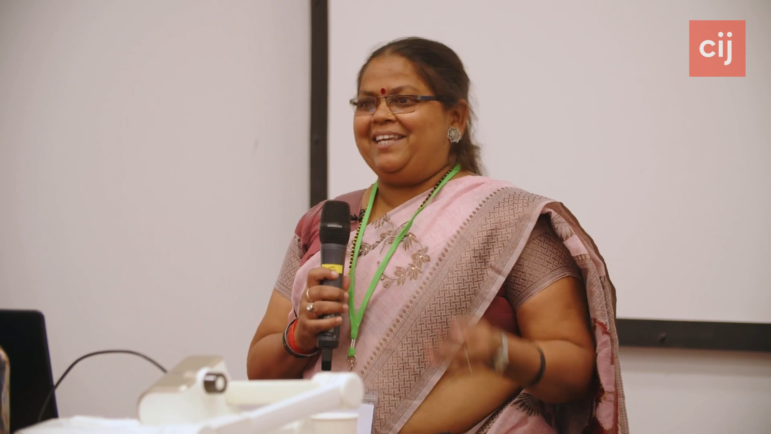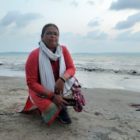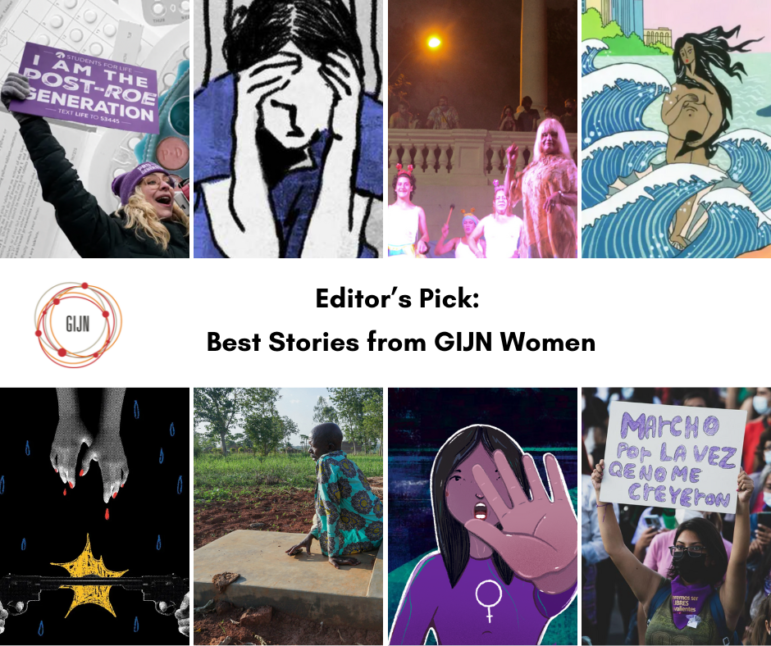

‘Picking Up Pens was a Revolutionary Act’: Telling the Stories of Marginalized, Rural Women in India
Read this article in
Editor’s note: Meera Jatav, co-founder of the award-winning, grassroots feminist media organization Khabar Lahariya, has won admiration for her courageous investigations into gender-based violence and caste in India. Here is the keynote speech she delivered at the Centre for Investigative Journalism’s summer investigative conference in London.
My warm greetings to our global journalistic fraternity. I am honored and delighted that the Centre for Investigative Journalism has kindly given me a platform to share my experience. My name is Meera Jatav, I am a journalist, and I am an anti-caste feminist.
To tell you the truth, I did not really expect to start the lecture with what I am about to tell you. But I think it is important for me to share. I left New Delhi airport on Tuesday morning. When I went up to collect my boarding pass, I was refused by the airlines. My documents were in order – visa, invite, and tickets – but I was refused. The airline said if I was a journalist I needed to show proof of accreditation. Then they said there were special rules that journalists need to be subjected to in background checks and surveillance. They also said the event was entirely in English and [asked] what was a rural, Hindi-speaking woman going to do at this event. This harassment lasted for nearly three-quarters of an hour before letting me pass through.
Why I think it’s important for me to share this is because it feels like journalism is a dangerous profession. That people think it’s a dangerous profession – now more than ever before. It feels like journalists are under threat now more than ever before.
To get back on track, I started my journey about 25 years ago from an underdeveloped region called Bundelkhand, Uttar Pradesh, in northern India. On May 31, 2002, seven of us – me and my comrades – who were Dalit, Bahujan [the non-upper caste population], Muslim rural women sowed the seeds of a hyper-local newspaper called Khabar Lahariya, which has now bloomed for all the world to see.
I’m here to tell you a little bit about our journey which has seen challenges and Pyrrhic victories from which I believe we all have something to learn.
You know I did read a bit about Gavin MacFadyen who started CIJ. I think the tough times CIJ was responding to is something we are seeing again today. I will confine myself to talking about my country and state. It is an unprecedented time of challenge for journalism. This is the time to hold power accountable yet we have chosen to shut up, say, and do nothing. Where powers that be haven’t yet asked us to bend, we are crawling.
Let me tell you about my state of Uttar Pradesh, which is at the forefront of criminalizing journalists who are doing their jobs. In fact, even ordinary citizens are being penalized for saying what they feel on social media, just what they feel. Uttar Pradesh also cuts a sorry figure in national crime statistics. And continues to be the most unsafe and violent state for women with the highest cases of violence. Uttar Pradesh also leads when it comes to crimes against marginalized social groups — about 25%, a quarter of all cases of violence against Dalits nationally, come from my state.

Illustration: Courtesy of Dr Andrew Salerno-Garthwaite
These statistics do not tell you the whole picture. You can perhaps imagine the cases of violence that do not make it to official records. Khabar Lahariya, built by the blood, sweat, and toil of Dalit Bahujan women has bloomed in such a violent desert. Our society has always put Dalit women at the bottom of the hierarchical social system, yet I have not heard a generation of such women who have found strength and voice, who are fearless and self-reliant. None of this was easy and it still is not.
The story of Khabar Lahariya is the story of a community of rural, marginalized, new literate women. It’s also a story of public interest journalism to write about what matters to us. In 2002, when our team of seven Bahujan women brought out a brand new newspaper called Khabar Lahariya, our region broke out in a furor. Who are these women who have dared to call themselves journalists? We were self-taught. We wanted to write in our own local dialect because we wanted women of the region to read us and to talk to us.
We were not trained in using computers. We were not trained in journalism. Our first print run was 1,000 copies and we sold each newspaper ourselves. In fact, this is what sets us apart from other media. Until Khabar Lahariya took a digital turn in 2016, we traveled mostly on foot from village to village looking for stories and distributing our newspaper. We went where governments, mainstream media, and politicians had never gone before. We listened to people’s stories. And we went back again and again. It took us years to be accepted – we were after all, Shudras and ex-Shudras, ex-“untouchable” communities – we faced and continue to face inequalities entrenched in caste, economics, and patriarchy.
I will forever remember the experiences of my Adivasi, Indigenous colleague Shanti. Villagers hurled slurs at her as she went about to report. They called her derogatory caste terms to her face, saying: ‘What do you, an uneducated woman, know about reporting?’ The first time we went about town to sell our newspaper, people assumed we were begging. The practice of “untouchability” is still not completely gone. We still face it where we live and where we work.
One of the first cases of violence against women Khabar Lahariya reporters reported was about an Indigenous woman in the remote forested area of Manipur, where ordinary lives were regularly caught in the crosshairs of outlaws, dacoits [bandits], and police. We heard a report of an Adivasi woman brutally assaulted by the police on the mere suspicion she may have given a meal to the dacoits.
We wrote prominently about the case and we called out the police for their brutality. Mainstream reporters in our area warned us. Some even threatened us, but we did not back down. In my view, this report cemented our reputation as a feminist newspaper and was a foreshadowing of things to come. That historically marginalized women picked up pens as weapons, to fearlessly demand answers in a society of entrenched inequalities, was a revolutionary act.

A 2019 Oxfam research report revealed how a lack of caste diversity plagues Indian newsrooms. Image: Screenshot
A recent report… by the Reuters Institute of Journalism says that views cannot reflect society until newsrooms do. What I am trying to say here is it’s the year 2022 and the media is still owned and editorially run by the powerful few and not the many. A 2019 Oxfam and Newslaundry research [report] revealed that Brahmins, who traditionally occupy the highest position in our hierarchical social system, and who constitute a mere four percent of [India’s] population, make up 88% of the newsroom. Dalits, a “backward” caste, and Indigenous, are 80% of the country and are not represented in newsrooms.
The findings of these reports are quite damning. There is not a single Dalit or otherwise “backward” caste Indigenous anchor on our TV channels. Five percent of total articles written in our English newspapers are written by Dalit/Bahujan/Adivasi journalists, and only 10% of Hindi newspapers, which is only slightly better. These are just statistics of representation or diversity, if you will. There is a whole ocean of experiences of Dalit/Baijun/Adivasi journalists in newsrooms that we don’t know of.
This is a question that has plagued Indian media since inception, in our opinion. Who are the authors of our stories, our lives, and our work? I see Khabar Lahariya as that perennially flowering plant in this media that has answers to our most fundamental — even existential — questions.
Could we imagine a space of journalism where the inequality between those investigating our stories and those who are written about is not this stark? Isn’t this what we have demonstrated at Khabar Lahariya, and successfully? Change did not happen overnight, of course, ours has been a two decade-long journey. But we have believed and stuck to our first principles. Rural marginalized women write on issues that matter to us and our communities. Rural marginalized women can wield the pen as easily as we did wage labor in a caste-ridden patriarchal society.
What do we write about? We write about the condition of roads and sewers. We write about the lack of access to electricity, water, and work. You might think these are very ordinary things to write about, but for us this is what makes the difference between whether villages get roads or not, whether Dalit neighborhoods are cleaned or not, whether hand pumps are fixed or not, in order for women to fulfill their family’s water requirements. We write about the unwaged, unseen labor of women who work in informal economies… We write about the Dalit woman whose complaint will not be taken up by the police because the perpetrator is a powerful, upper-caste male.
It is vitally important for us to write on these issues as this is our life experience. Society does not deal well when marginalized women step out of the boundaries they have been confined to. They take their anger out on us. They scrutinize, criticize, and penalize us, for what we wear, what we eat, where we live, how we speak. Society is also scared of what we are trying to bring about: a fair, just, equal society for everyone.
Ours is a society where the woman is blamed first, no matter what the issue at hand is. And that is the discourse we have changed. We have centered women’s – particularly marginalized women’s – voices and experiences, and we have named and shamed powerful perpetrators.
This is not to say this is a battle that we have won. Far from that. What we face in society we deal with in our families on a daily basis. Only we know what the cost is of raising our voices relentlessly every single day.
I hope there are people in the audience who have seen “Writing with Fire,” the documentary that came out this year. This documentary tells the stories of three of my comrades, which is a slice of their lives. You might have seen how women marginalized by society negotiate with discrimination and dismissal, you might have seen them demand answers from power, whoever that power is. You might have seen them talk of their dreams and hopes.
Additional Resources
How a Rural Women’s Paper Became a Muckraking Phenomenon in India
What to Watch: Oscar-Nominated Feature Documentaries
Resources for Female-Identifying Journalists – A GIJN Guide
 Meera Jatav, the co-founder of the award-winning, grassroots feminist media organization Khabar Lahariya, is from Bundelkhand in India’s Uttar Pradesh state. She has won admiration for her courageous investigations into gender-based violence and caste in India.
Meera Jatav, the co-founder of the award-winning, grassroots feminist media organization Khabar Lahariya, is from Bundelkhand in India’s Uttar Pradesh state. She has won admiration for her courageous investigations into gender-based violence and caste in India.









